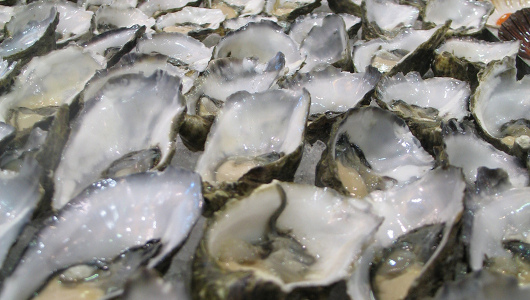Posted on Mother Nature Network: 8 Aug 2012 — By John Platt — Ocean acidification has reduced some oyster yields by 80% or more.
Oysters on the half shell may be a delicacy, but oysters need their shells to grow and thrive in the first place. Unfortunately, increasing levels of ocean acidification caused by carbon-dioxide emissions and climate change threaten the integrity of oyster shells — and therefore the tasty mollusks themselves — and the oyster industry around the world is struggling to adapt.
Oyster hatcheries and nurseries in the Pacific Northwest started seeing the effect of ocean acidification in the middle of the last decade when oyster larvae started dying after their shells were corroded, NPR station WRVO recently reported. The region’s oyster farms saw a 60 percent drop in production in 2008 and another 80 percent drop the following year. The cause, as determined by National Oceanic and Atmospheric Administration research scientist Richard Feely, was increased anthropogenic CO2 in the ocean water.
In addition to the lowered productivity, there was another potential danger: Oysters also develop their flavor based on the waters in which they grow. Although Pacific Northwest oysters haven’t yet taken on an unappetizing flavor from the more acidic oceans, it remains a risk that could further impact the region’s industry.
The oyster industry, with Feely’s help, has spent the last few years adapting to the more acidic oceans. Expensive monitoring equipment was purchased — with federal assistance — that delivers ocean water to hatcheries during the afternoon, the time of day when it is least acidic.
Meanwhile, some hatcheries have moved their operations to Hawaii, where the waters are not yet as acidic. The cold waters of the Pacific Northwest and similar regions are more at risk from ocean acidification, according to a study by the British Antarctic Survey published on Aug. 6 in the journal Global Change Biology. The study found that shellfish ranging from lobsters to oysters to sea urchins will have a harder time growing their skeletons and shells. It could also affect algae, which could become less able to protect themselves from predators, affecting the entire food web.
Rising sea levels from climate change could also affect oyster populations. Last month the Coastal Conservancy and other organizations started dropping half a million oyster shells into the San Rafael Bay to try to boost local populations. Those oysters aren’t destined for the dinner plate, however. Instead, they are intended to help filter and clean the polluted waters and create a natural barrier to protect the shore against tidal surges, which are expected to increase as sea levels rise.
Outside the U.S., other projects hope to protect oysters against rising temperatures and increasing ocean acidification. In Australia, the Sydney Institute of Marine Science is studying the genetics of oysters and other marine species to see if they can identify which genes make them the most resistant to climate change. The long-term goal of the project is to “climate proof” the Australian oyster industry.
Ocean acidification will be the subject of the Third Symposium on the Ocean in a High‐CO2 World, to be held in Monterey, Calif., in September.
